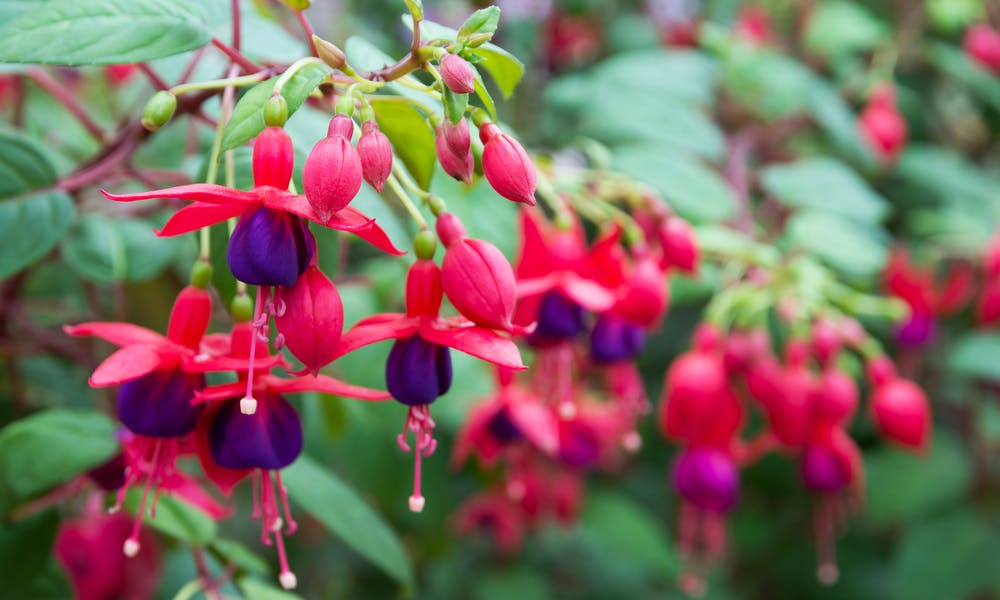Fuchsia flowers are very unique and exotic flowers. Well known for their bright colors, these beautiful flowers stand out in any landscape. They are originally from Central and South America and usually grow on shrubs or trees. If you want to learn more about the captivating fuchsia plant, this article explains all you need to know!
Here is what this article explains:
– an overview of the fuchsia plant
– the flower’s symbolism
– the history of the plant
– the best place and season to plant
– how to grow and care for fuchsias
Overview of the Fuchsia Plant
The fuchsia plant is an exotic plant that comes from Central and South America. The flowers that grow from the plants possess a mesmerizing dark pink color- fuchsia- that stands out among their dark green foliage. The petals are bell-shaped and open out to reveal brilliant colors. Although their name is fuchsia, not all the flowers are this color. There are some species that have purple, white, and red petals.
There are multiple species of fuchsia plants, so, there are a variety of sizes. Many of the fuchsia shrubs grow to be around one to three feet in height. The trees are a bit taller, ranging from three to eight feet. Both the shrubs and trees have a width between one and five feet. Therefore, fuchsias bring a burst of color to your garden without taking up too much space.
Fuchsias look great in any garden. As with any other plant or flower, it is recommended that they are grown in gardens or in pots. But most people enjoy planting fuchsias in hanging baskets due to the nature of the flowers’ stems.
The Symbolism of Fuchsias
As with most other flowers, fuchsias represent different symbols that make them unique. This flower indicates confiding love. So, generally, fuchsias are given as a way of expressing your trust for someone.
Fuchsia flowers are also associated with different myths. In the past, some people believed that this flower was sent as a warning for others. So, they would be left in front of homes as a form of protection. There are also tales that mention that fuchsia could be used to make fairies or women. Because of their outstretched petals that look like a skirt and their stamen that look like legs, it was thought that, with special actions, fuchsia could miraculously form humans and fairies.
The History of Fuchsia Plants
Coming from Central and South America, the fuchsia plant and their supplemental flowers were discovered by western science sometime between the late 17th century and the early 18th century. A French botanist named Father Charles Plumier recorded the plant after encountering them in the Dominican Republic. He named the flowers after his colleague- Leonhart Fuchs- who was a German herbalist and botanical illustrator.
After Plumier’s discovery, he took seeds of the flowers to England where research and experiments were carried out on the flower. Soon after, there came to be over 100 different species and hybrids of fuchsia plants.
The fuchsia plant and their flowers became very popular during the Victorian Era. The plant’s popularity declined shortly after. In 1929, there was a resurgence in popularity as the American Fuchsia Society was formed. Later, more groups that focused on this flower were established, such as the British Fuchsia Society in 1938 and the National Fuchsia Society in 1954.
Today, fuchsia flowers and plants are beloved all over the world as shown through their presence in gardens and flowerpots.
The Best Place and the Best Season to Plant Fuchsias
While Fuchsias are not difficult to grow and maintain, there are a large variety of species. So, some blooming periods may be different than others. It is important to pay attention to the species of fuchsia. With that being said, they can be either annual or perennial plants- it all depends on the kind of fuchsia.
Overall, these flowers bloom between summer and fall. Therefore, the best time for planting them is during the springtime. They thrive on cooler temperatures which is why they blossom later in the year.
When considering a good place to plant your fuchsia plant, make sure to select an area that offers plenty of shade. While making sure the flower receives plenty of sunlight, fuchsia grow and survive well in the shade. However, if you live in an area that is generally cooler all year, then fuchsia will do well in full sunlight.
How to Grow and Care for Fuchsia
The best things to focus on when caring for fuchsia are temperature and water. As mentioned before, fuchsia grow very well in cooler areas. So, during warmer seasons, it is best that they get lots of shade. You can balance out temperature by adding water. Water provides necessary nutrients for the plant while being a mechanism to cool it down.
It is very important to keep track of water when it comes to fuchsia plants. The soil cannot be too dry or too wet. So, when watering, it is best to make sure that the soil is damp but does not create puddles of water on the soil. The soil should be able to drain easily, as should the pot. When the water stays within the soil for too long the roots could be damaged. Overall, a balance between water and sunlight can ensure the healthy growth of fuchsia plants.
Fertilizing the fuchsia plants is also recommended for healthy flowers. By adding fertilizer every two weeks or so, you can add more nutrients to the plant that can strengthen it and ensure its bloom for the next season. In addition, it is important to watch out for insects that can grow in the petals. Often, insects attach themselves inside the pockets between petals and can cause harm. Therefore, be sure to remove these flowers if you see any harmful insects. If you follow these tips, then you can grow beautiful fuchsia flowers that will brighten up your garden!
